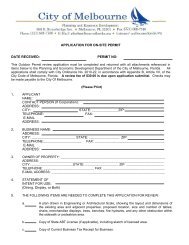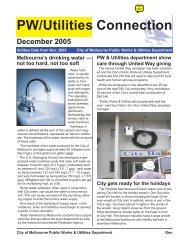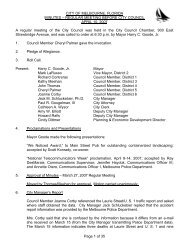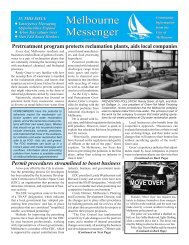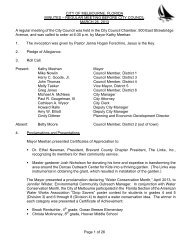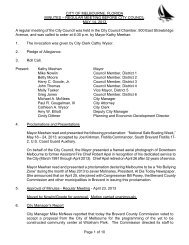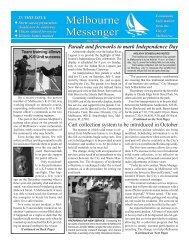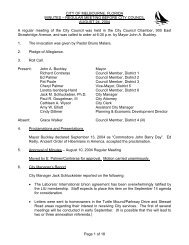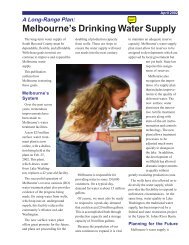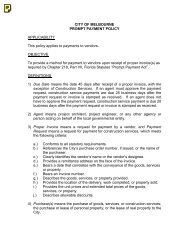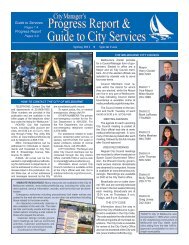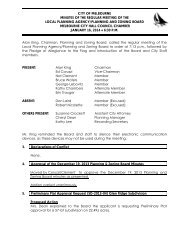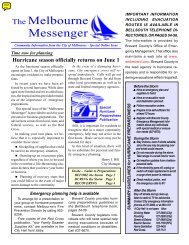Historic Guidelines - City of Melbourne, Florida
Historic Guidelines - City of Melbourne, Florida
Historic Guidelines - City of Melbourne, Florida
You also want an ePaper? Increase the reach of your titles
YUMPU automatically turns print PDFs into web optimized ePapers that Google loves.
REHABILITATION AND ADDITIONS<br />
Maintenance<br />
The owner <strong>of</strong> a structure within a historic district or <strong>of</strong> a designated landmark should not permit<br />
such structure or landmark to fall into a state <strong>of</strong> disrepair which may result in the deterioration <strong>of</strong> any<br />
exterior appurtenance or architectural feature so as to produce a detrimental effect upon the character<br />
<strong>of</strong> the district as a whole or the life and character <strong>of</strong> the landmark or structure in question.<br />
Nothing in this document should be construed to prevent the ordinary maintenance or repair <strong>of</strong><br />
any exterior feature in a historic district or <strong>of</strong> any landmark which does not involve a change in design,<br />
material, color, or other appearance there<strong>of</strong>.<br />
Property owners should adhere to the following standards when performing ordinary<br />
maintenance on buildings within the district.<br />
1) The surface cleaning <strong>of</strong> structures should be undertaken with the gentlest means possible.<br />
Sandblasting, and the use <strong>of</strong> abrasive, corrosive or damaging techniques for cleaning should be<br />
prohibited as they could damage the historic building materials.<br />
2) Paint removal is another threat to historic wood siding. The proper method for removing paint is<br />
cleaning, light scraping and sanding down the next sound layer. If more intensive paint removal is<br />
required, the gentlest means possible should be used. Harsh abrasive methods such as rotary<br />
sanding discs, rotary wire strippers, and sandblasting should never be used to remove paint from<br />
exterior wood. Such methods leave visible circular depressions in the wood; shred the wood, or<br />
erode the s<strong>of</strong>t, porous fibers <strong>of</strong> the wood, leaving a permanently pitted surface.<br />
3) Clean wood using the gentlest means possible. Repair trim and siding before applying paint. Seal<br />
holes, caulk cracks, and treat for wood fungus. Remove loose paint using commercial strippers,<br />
electric heat guns or plates, wire brushes and scrapers. Hand sand to reduce paint layer differential.<br />
4) Abrasive cleaning methods should be avoided using such devices as rotary sanding or wire brushing,<br />
sand blasting or extreme high pressure washing (PSI <strong>of</strong> more than 100) or harsh thermal methods<br />
such as propane or butane torches.<br />
5) Masonry should be cleaned only when necessary to halt deterioration or remove heavy soiling. Clean<br />
masonry surfaces with the gentlest method possible, such as water and detergents and natural<br />
bristle brushes. While masonry is the most durable historic building material, the cleaning <strong>of</strong> historic<br />
masonry is a special consideration because it is susceptible to damage by improper maintenance<br />
or repair techniques and abrasive cleaning methods. Sandblasting changes the visual qualities <strong>of</strong><br />
brick, and damages and destroys the exterior glazing. As a result, rapid deterioration <strong>of</strong> the brick and<br />
potential water damage to the interior <strong>of</strong> the building are possibilities.<br />
6) Avoid sandblasting brick or stone surfaces using dry or wet grit or other abrasives. Such methods <strong>of</strong><br />
cleaning permanently erode the surface <strong>of</strong> the material and accelerate deterioration.<br />
7) Paint historically unpainted masonry only if it has been previously painted or as a protective measure<br />
to prevent further deterioration caused by poor quality materials prior to abrasive cleaning.<br />
8) Treat mortar joint deterioration from leaking ro<strong>of</strong>s or gutters and differential settlement <strong>of</strong> the<br />
building.<br />
9) Evaluate the overall condition <strong>of</strong> the masonry to determine whether repairs rather than protection<br />
and maintenance are required.<br />
10) Protect leaking ro<strong>of</strong>s with plywood and building paper until it can be properly repaired.<br />
11) Protect and maintain masonry by providing proper drainage so that water does not stand on flat,<br />
horizontal surfaces or accumulate in curved decorative features.<br />
DRAFT<br />
31



